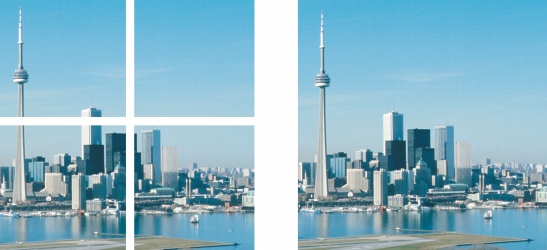Quick links to procedures on this page:
Stitching images together
Image stitching allows you to seamlessly join 2D images. For instance, you can scan a large image in smaller, overlapping pieces and reassemble them.

You can stitch images together to create a single, large image. This image has been scanned in four sections and stitched.
In Corel PHOTO-PAINT, you can stitch multiple images interactively. You can select, move, and rotate the images, as well as change your view of them to allow more precise positioning. As you position the images, overlapping areas will turn black to signal that you have aligned the edges correctly. You can then save the stitched images as a single, flattened image, or as objects that you can continue to edit individually.
You can stitch images in all color modes except black-and-white, duotone, 16-bit grayscale, 48-bit RGB, and multichannel. If the selected images use the same color mode, except paletted color mode, the new file will use that color mode as well. If the selected files use a different color mode, or are all paletted color mode, the new file uses RGB color mode. For more information about color modes, see “Changing color modes.”
To stitch images together |
|
4.
|
|
To change the position of an image in the Selected files list, click a filename, and click one of the following buttons:
|
|
8.
|
|
Type a value in the Blend image list box to define the number of overlapping pixels used to blend images together.
|
|
•
|
Create objects from images — creates a stitched image in which each source image becomes a separate object. You can later adjust the brightness and contrast of each object so they match.
|
![]()
|
•
|
|
Stitched images that are flattened have a smaller file size than stitched images containing separate objects.
|
![]()
|
•
|
|
Use the Arrow keys with the Selection tool, the Rotate tool, and the Pan tool to move, rotate and view images precisely in the image stitch window.
|